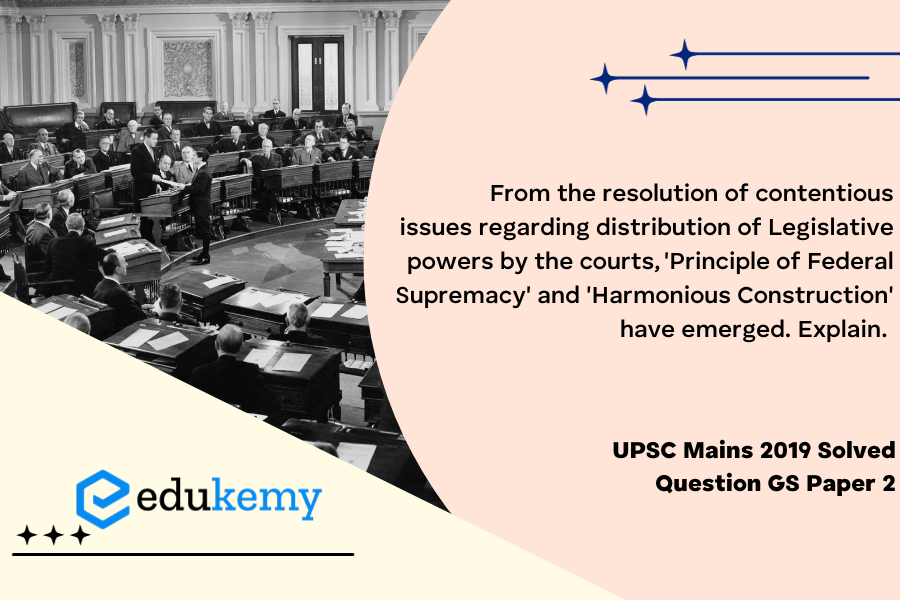The resolution of contentious issues surrounding the distribution of legislative powers by the courts has given rise to two crucial principles in constitutional law: the ‘Principle of Federal Supremacy’ and ‘Harmonious Construction.’ These principles play a pivotal role in maintaining a delicate balance between federal and state authorities within a constitutional framework. The Principle of Federal Supremacy asserts that in case of a conflict between federal and state laws, the federal law prevails, emphasizing the overarching authority of the national government. This principle is rooted in the supremacy clause of the Constitution, highlighting the need for a unified legal system to prevent inconsistencies and ensure the uniform application of laws across the nation. On the other hand, the ‘Harmonious Construction’ principle encourages the interpretation of constitutional provisions and statutes in a manner that avoids conflicts between different levels of government. It promotes a cooperative and collaborative approach, urging courts to reconcile potential conflicts and find a harmonious coexistence between federal and state laws. Together, these principles provide a legal framework that fosters unity, coherence, and effective governance while respecting the distinct spheres of authority allocated to the federal and state governments.
Tag: Issues and challenges pertaining to the federal structure.
Contents
Decoding the Question:
- In Introduction, try to briefly write about federalism in India.
- In Body,
- Discuss the Principle of Federal Supremacy.
- Also discuss the Principle of Harmonious Construction.
- In Conclusion, try to wind up stating significant federalism.
Answer:
In the Indian Constitution the word ‘federalism’ is nowhere mentioned, but it constitutes the basic structure of the Indian Constitution. Indian Constitution provides for a three-fold distribution of legislative subjects between the Union list, the state ist, and the Concurrent List in the Seventh Schedule. However, contention develops in categorization of legislation into the entries of these three lists. To resolve these contentions, courts have evolved various principles.

Principle of Federal Supremacy:
- When a statute’s provisions fall in both state and union lists, then the center would have the dominant legislative power. The state and concurrent lists are subordinate to the Union list. The Supreme Court can apply this principle as a last resort if attempts to find a solution under the Principle of Federal Supremacy fail.
- In the West Bengal case of 1963, the legislative competence of the Parliament to enact a law for compulsory acquisition by the Union of land and other properties vested in or owned by the State was examined. The Court held that both the legislative and executive powers of the States are subject to the respective supreme powers of the Union. SC also said that the Indian Union as provided by the Constitution is centralized, with the States occupying a secondary position vis-à-vis the Centre.
Principle of Harmonious Construction:
- The term harmonious construction refers to such construction by which harmony or oneness amongst various provisions of an enactment is arrived at.
- Harmonious construction is a principle of statutory interpretation used in the Indian legal system. It holds that when two provisions of a legal text seem to conflict, they should be interpreted so that each has a separate effect, and neither is redundant or nullified.
- In Shri Krishna Ranganath Mudholkar Vs Gujarat University,1963 case ‘Harmonious Construction’ was mentioned. It is the thumb rule to the interpretation of any statute. The court used this principle to allow the State government to make law on excluded items(reserved for the centre) as an extension to its power to legislate on education, to the extent it does not contradict the union law.
In the era of cooperative and competitive federalism, conflicts should be minimized as far as possible. States should bring reform in important areas like police, agriculture marketing, etc., and coordinate with other states and centres to have a uniform legislative framework in key areas. With the recent steps like one nation, and One Ration Card, more federal cooperation would be necessary.
India is a country of continental dimensions along with immense diversities and social problems. The framers of the Constitution believed that it required a federal Constitution that would accommodate diversity. Federalism celebrates both unity as well as diversity, it is like a rainbow, where each color is separate, yet together they make a harmonious pattern. Both principles play an important role in the interpretation of statutes for the smooth functioning of government.
In case you still have your doubts, contact us on 9811333901.
For UPSC Prelims Resources, Click here
For Daily Updates and Study Material:
Join our Telegram Channel – Edukemy for IAS
- 1. Learn through Videos – here
- 2. Be Exam Ready by Practicing Daily MCQs – here
- 3. Daily Newsletter – Get all your Current Affairs Covered – here
- 4. Mains Answer Writing Practice – here


